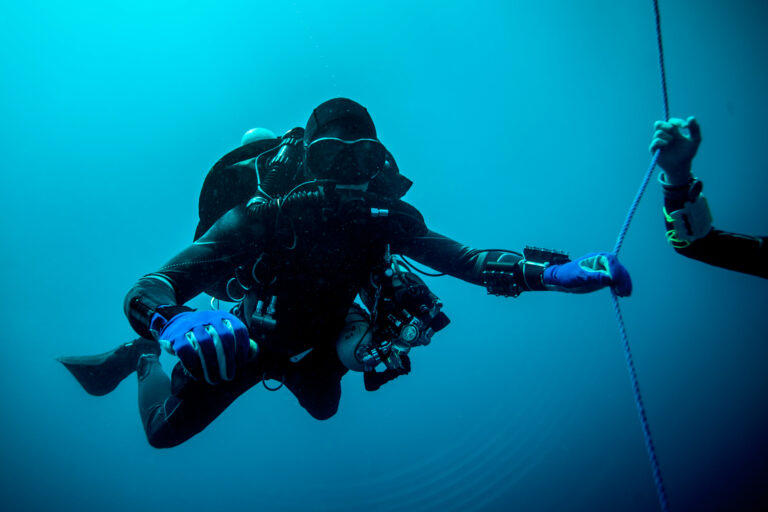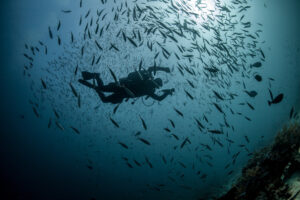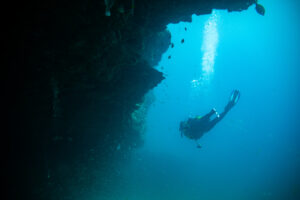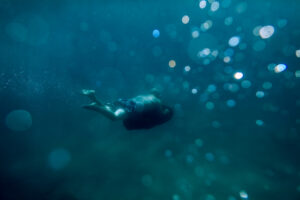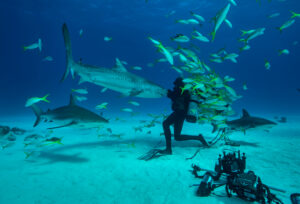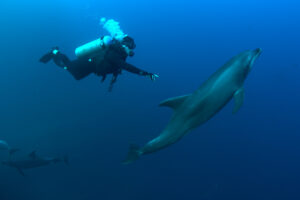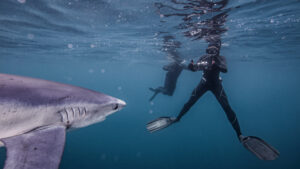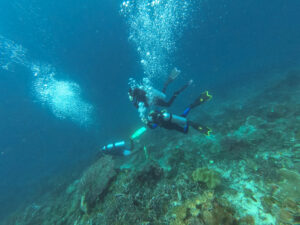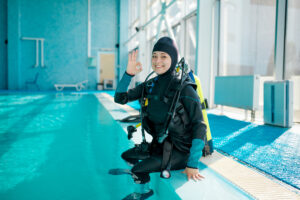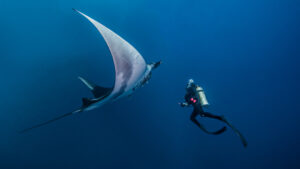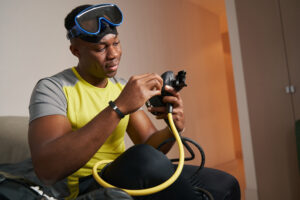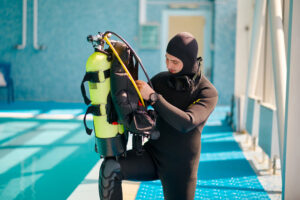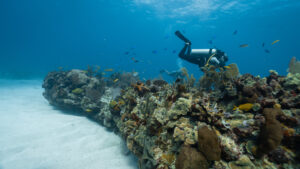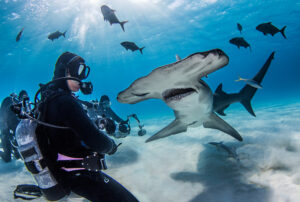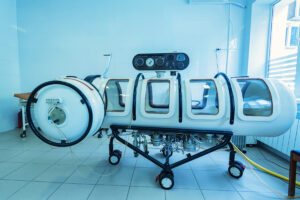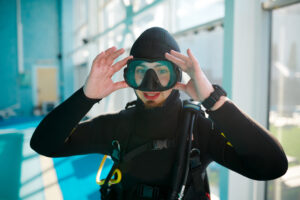What is a Rebreather?
A rebreather is a sophisticated and technologically advanced piece of diving equipment that allows divers to maximize their time underwater while minimizing the environmental impact of their dive. Unlike traditional open-circuit scuba systems, which release exhaled air into the water, rebreathers filter and recirculate the exhaled air, allowing divers to breathe the same air multiple times. This closed-circuit system significantly reduces the amount of gas consumed during a dive and enables divers to explore deeper depths and stay submerged for longer periods. However, using a rebreather requires specialized training and knowledge to ensure safe and efficient operation.
History and Development
The concept of rebreathers dates back to the early 20th century, with the invention of the Davis Submerged Escape Apparatus (DSEA) in 1910. This rudimentary device was designed to provide oxygen for a short period, allowing submariners to escape a submerged vessel. Over the years, the technology evolved to include semi-closed and fully-closed circuit systems, each with their unique benefits and applications.
During World War II, military divers employed rebreathers for clandestine operations due to their minimal bubble release and low noise output. The technology continued to improve, and by the 1960s, rebreathers were utilized by commercial and scientific divers. With advancements in electronics and material sciences, modern rebreathers have become more reliable, efficient, and user-friendly, making them accessible to recreational divers.
Types of Rebreathers
There are three main types of rebreathers: oxygen (O2) rebreathers, semi-closed circuit rebreathers (SCR), and closed-circuit rebreathers (CCR).
- Oxygen Rebreathers: These systems use pure oxygen as the breathing gas and are limited to shallow depths, typically less than 20 feet (6 meters). Oxygen rebreathers are mostly used in military applications and specialized fields like underwater photography, where minimal bubble release is crucial.
- Semi-Closed Circuit Rebreathers (SCR): SCRs mix the exhaled gas with a predetermined amount of fresh gas, which is typically a Nitrox blend. A portion of the exhaled gas is vented to the surrounding water, while the remainder is filtered and recirculated. SCRs are more efficient than open-circuit systems but less efficient than CCRs. They are popular among technical divers for their simplicity and cost-effectiveness.
- Closed-Circuit Rebreathers (CCR): The most advanced type, CCRs recycle all exhaled gas, resulting in minimal gas consumption and no bubble release. CCRs use a combination of oxygen and diluent gases, such as air, Nitrox, or Trimix, to maintain a constant partial pressure of oxygen (PPO2) during the dive. This makes CCRs ideal for deep dives and extended bottom times.
Components of a Rebreather
A rebreather consists of several key components, including:
- Gas Supply: Rebreathers use high-pressure cylinders to store breathing gases. Typically, a CCR will have separate cylinders for oxygen and diluent gas.
- Counterlung: The counterlung is a flexible bag that expands and contracts as the diver inhales and exhales, allowing for the recirculation of exhaled gas.
- Scrubber: The scrubber is a canister filled with a chemical absorbent, usually a granular form of soda lime, which removes carbon dioxide (CO2) from the exhaled gas.
- Gas Addition System: This system adds fresh gas to the breathing loop to compensate for the consumed oxygen and maintain the desired PPO2. In CCRs, electronic control systems monitor PPO2 levels and adjust the gas mixture accordingly, while manual systems require the diver to make adjustments as needed.
- Sensors and Electronics: Modern rebreathers employ sophisticated electronics to monitor PPO2, gas pressure, and other vital parameters. These systems can provide real-time data to the diver through a heads-up display (HUD) or a wrist-mounted computer.
- Mouthpiece and Breathing Loop: The mouthpiece allows the diver to breathe from the system, and the breathing loop connects the mouthpiece to the counterlung and scrubber, facilitating the circulation of gases.
- Bailout Valve: The bailout valve is a crucial safety feature that enables the diver to switch from the rebreather to an open-circuit regulator in case of an emergency or malfunction.
Rebreather Training and Certification
Due to the complexity of rebreathers and the potential risks associated with their use, specialized training is required to ensure safe and efficient operation. Rebreather training courses are typically offered by professional scuba diving organizations and focus on equipment setup, maintenance, emergency procedures, and dive planning specific to the use of rebreathers.
Rebreather certifications are typically divided into several levels, with each level focusing on different aspects of rebreather diving:
- Rebreather Diver: This entry-level course introduces divers to the basics of rebreather operation and maintenance. Graduates are qualified to dive with a specific type of rebreather within recreational depth limits.
- Advanced Rebreather Diver: This course expands on the skills learned in the Rebreather Diver course, allowing divers to explore deeper depths and more challenging environments.
- Technical Rebreather Diver: This advanced course covers the use of rebreathers in decompression diving, mixed-gas diving, and other technical diving applications.
- Rebreather Instructor: Rebreather Instructors are qualified to teach rebreather courses and certify new rebreather divers.
Benefits and Limitations
Rebreathers offer several advantages over traditional open-circuit scuba systems, including:
- Longer Dive Times: By recirculating exhaled gas, rebreathers drastically reduce gas consumption, allowing for extended dive times.
- Silent Diving: The absence of bubbles makes rebreathers ideal for underwater photography, videography, and marine life observation, as they do not disturb the surrounding environment.
- Enhanced Decompression: The constant PPO2 maintained by CCRs can provide divers with more efficient decompression profiles, reducing the risk of decompression sickness.
However, rebreathers also come with certain limitations and risks, such as:
- Complexity: The operation of a rebreather requires specialized training and knowledge, as well as regular maintenance and pre-dive checks.
- Cost: Rebreathers are significantly more expensive than open-circuit systems, both in initial investment and ongoing maintenance costs.
- Potential Malfunctions: The intricate components and electronic systems of rebreathers can be prone to malfunctions, requiring divers to be well-trained in emergency procedures and carry redundant systems.
Rebreathers have revolutionized the world of scuba diving, providing unparalleled benefits in terms of dive duration, depth, and environmental impact. However, their complexity and potential risks necessitate specialized training and a commitment to ongoing education and maintenance. For those willing to invest the time and resources, rebreathers can unlock new underwater adventures and experiences beyond the reach of traditional scuba diving systems.

